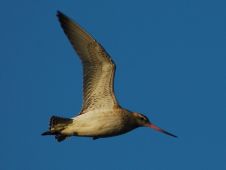
The Bar-tailed Godwit Limosa lapponica undertakes one of the avian world’s most extraordinary migratory journeys. One bird was recently tracked flying more than 12,000 km from Alaska to New Zealand in 11 days—the longest continuous journey that has ever been recorded for a landbird.

The East Asia/Australasia Flyway contains two Bar-tailed Godwit subspecies: L. l. menzbieri, which nests in north-eastern Siberia and spends the northern winter in South-east Asia and western Australia, and L. l. baueri, which breeds in western Alaska and migrates to New Zealand and south-east Australia for the non-breeding season. The flyway population is estimated at 325,000, comprising roughly 170,000 menzbieri and 155,000 baueri (Delany and Scott 2006, Bamford et al. 2008, Hansen et al. 2016).
Ornithologists have long suspected that the Bar-tailed Godwit was capable of making an immense journey in a single haul (Gill et al. 2005). However, the true scale of their migratory feats has only recently been confirmed. In 2007, researchers from the Pacific Shorebird Migration Project, a joint initiative between the U.S. Geological Survey (USGS) and PRBO Conservation Science, used satellite telemetry to follow the birds’ migration. Individuals of the baueri race were fitted with small transmitters whilst on the ‘wintering’ grounds in New Zealand (Gill et al. 2009).
The birds began their northward migration in mid-March, typically completing the journey in two stages. First, the godwits follow the west Pacific Rim to the Yellow Sea, which lies between mainland China and the Korean peninsula. This leg, of over 10,000 km, is completed in a single flight and takes between six and eight days. The North Yellow Sea, particularly the area around the Yalu Jiang Nature Reserve, is an extremely important staging site, with almost the entire baueri race believed to pass through the area each spring. The birds remain here for several weeks before continuing on to their Alaskan breeding grounds, where they stay for much of June and July. In August, the birds ‘bulk up’ at coastal staging sites such as Kuskokwim Shoals off the mouth of the Kuskokwim River. Immediately prior to departure, their fat reserves constitute over half their body weight, whilst their gizzards and intestines, which are not needed during flight, shrink to almost nothing (Piersma et al. 1998). The birds depart Alaska in late August, embarking on a remarkable non-stop flight directly across the central Pacific Ocean. Aided by strong tailwinds, the birds average 56 km per hour and can complete the 11,000 km journey in just over eight days. In 2020, The Global Flyway Network tracked a male bird that flew more than 12,000 km in 11 days on its journey from Alaska to New Zealand – the longest recorded non-stop flight of any bird. With a total round-trip of 29,000 km it is likely that a typical Bar-tailed Godwit of the baueri race will fly more than 460,000 km during the course of its lifespan.
Related Case Studies in other sections
Related Sites
Related Species
Links
Bar-tailed Godwit breaks record for non-stop flight
References
Bamford, M., Watkins, D., Bancroft, W., Tischler, G. and Wahl, J. (2008) Migratory Shorebirds of the East Asian - Australasian Flyway; population estimates and internationally important sites. Canberra: Wetlands International - Oceania.
Delany, S. and Scott, D. (2006) Waterbird Population Estimates. Fourth Edition. Wageningen: Wetlands International.
Gill, R. E., Piersma, T., Hufford, G., Servranckx, R. and Riegen, A. (2005) Crossing the ultimate ecological barrier: Evidence for an 11,000-km-long nonstop flight from Alaska to New Zealand and eastern Australia by Bar-Tailed Godwits. Condor 107: 1–20.
Gill, R. E., Tibbitts, T. L., Douglas, D. C., Handel, C. M., Mulcahy, D. M., Gottschalck, J. C., Warnock, N., McCaffery, B. J., Battley, P. F. and Piersma, T. (2009) Extreme endurance flights by landbirds crossing the Pacific Ocean: ecological corridor rather than barrier? Proc. R. Soc. Lond. Ser. B 276: 447–457.
Hansen, B.D., Fuller, R.A., Watkins, D., Rogers, D.I., Clemens, R.S., Newman, M., Woehler, E.J., Weller, D.R. (2016) Revision of the East Asian-Australasian Flyway Population Estimates for 37 listed Migratory Shorebird Species. Unpublished report for the Department of the Environment. Melbourne: BirdLife Australia.
Piersma, T. and Gill, R. E. (1998) Guts don’t fly: small digestive organs in obese bar-tailed godwits. Auk 115: 196–203.
Compiled: 2010 Last updated: 2020
Recommended Citation:
BirdLife International (2020)
The Bar-tailed Godwit undertakes one of the avian world's most extraordinary migratory journeys .
Downloaded from https://datazone.birdlife.org/sowb/casestudy/the-bar-tailed-godwit-undertakes-one-of-the-avian-worlds-most-extraordinary-migratory-journeys- on 22/12/2024